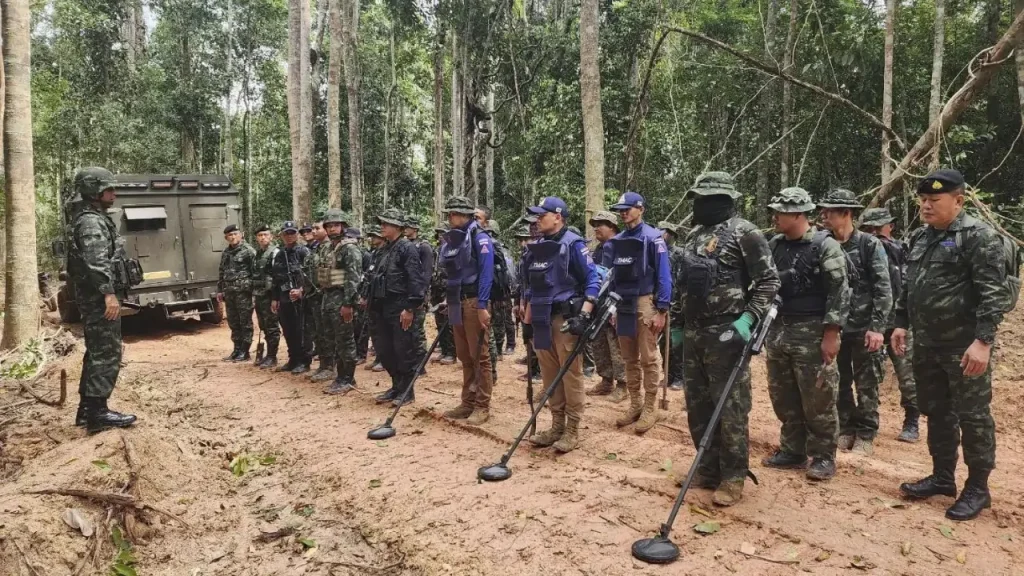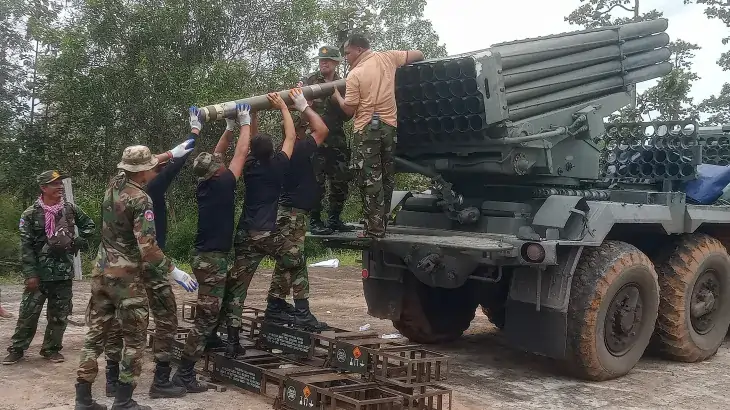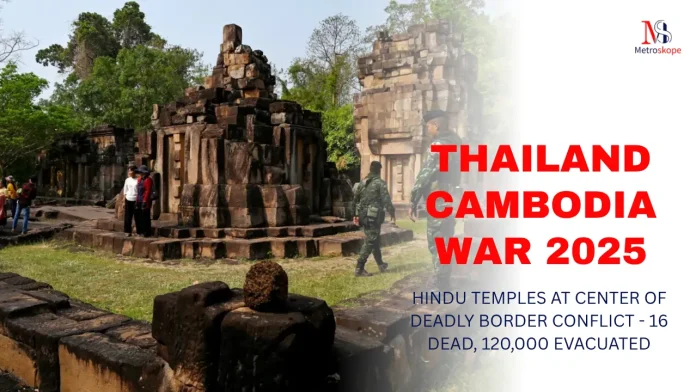The Thailand-Cambodia border has become a war zone as deadly clashes over disputed Hindu temples have escalated into the most severe military confrontation between the two Southeast Asian nations in over a decade.
The conflict, centered around ancient Khmer temples dedicated to Lord Shiva, has claimed 16 lives and forced over 120,000 people to flee their homes.
Current Death Toll and Evacuation Crisis
The violence, which erupted on July 24, 2025, has created a humanitarian crisis along the 817-kilometer Thailand-Cambodia border. Thailand’s Health Ministry confirmed 15 deaths on the Thai side, including 14 civilians and one soldier, while Cambodia reported one civilian casualty.
The conflict has displaced approximately 100,672 people from four Thai provinces – Surin, Sisaket, Buriram, and Ubon Ratchathani – who have been relocated to emergency shelters.
On the Cambodian side, around 1,500 families in Oddar Meanchey province have been evacuated from border areas as heavy artillery exchanges continue into the second day.
The scale of displacement highlights the intensity of hostilities that have spread across six flashpoints along a 209-kilometer border stretch.
The Sacred Hindu Temples at the Heart of Conflict

Ta Muen Thom Temple Complex: The Current Battleground
The immediate trigger for the current violence centers around the Prasat Ta Muen Thom temple, an 11th-century Hindu shrine dedicated to Lord Shiva.
Built during the reign of King Udayadityavarman II, this ancient temple sits atop the dense Dangrek Mountains along the Thailand-Cambodia border.
The temple complex consists of three main structures:
- Prasat Ta Muen Thom: The largest structure featuring a naturally formed Shivling and Sanskrit inscriptions
- Prasat Ta Muen: A Mahayana Buddhist site that served as accommodation for travelers
- Prasat Ta Muen Tot: A hospital shrine for the local community
The fighting began when Thai forces reported spotting Cambodian drones conducting surveillance near the temple, followed by armed Cambodian soldiers approaching Thai positions.
Cambodia disputes this narrative, claiming Thai forces initiated the attack and violated Cambodian territorial sovereignty.
Preah Vihear Temple: The Historical Flashpoint
The broader dispute traces back to the 900-year-old Preah Vihear temple, another Hindu shrine dedicated to Lord Shiva, perched on a 525-meter cliff in Cambodia’s Dangrek mountains.
This UNESCO World Heritage site has been the subject of a century-long territorial dispute between the two nations.
International Court Rulings and Colonial Legacy
The legal foundation of the dispute stems from colonial-era treaties signed between 1904-1907 when Cambodia was under French protection.
French surveyors created maps based on watershed lines, placing Preah Vihear within Cambodian territory.
Key Legal Milestones:
- 1962: International Court of Justice (ICJ) ruled in favor of Cambodia’s sovereignty over Preah Vihear temple, ordering Thailand to withdraw troops
- 2013: ICJ clarified that not only the temple but also the surrounding area belongs to Cambodia
- 2008: Cambodia’s successful bid to list Preah Vihear as a UNESCO World Heritage site triggered renewed tensions
Despite these rulings, Thailand has consistently disputed the colonial-era maps, arguing it had accepted them under the mistaken belief that borders followed natural watershed lines.
Military Escalation and F-16 Deployment
The current conflict represents a significant military escalation, with Thailand deploying six F-16 fighter jets in combat operations – a rare move that highlights the severity of the situation.
Thai F-16s reportedly bombed Cambodian military positions, prompting Cambodia to label the action as “reckless and brutal military aggression”.
Weapons Systems in Use:
- Thailand: F-16 fighter jets, artillery systems, advanced military technology
- Cambodia: BM-21 multiple rocket launchers, RPGs, drones
The deployment underscores Thailand’s military superiority over Cambodia, which lacks fighter aircraft and has significantly fewer defense resources.
Diplomatic Breakdown and Regional Response
The conflict has triggered a complete diplomatic breakdown between the neighboring countries:
- Both nations have expelled each other’s ambassadors
- All border checkpoints have been completely closed
- Diplomatic relations have been downgraded to their lowest level in decades
International Calls for Ceasefire

Regional and global leaders have urgently called for de-escalation:
- Malaysian Prime Minister Anwar Ibrahim, who leads ASEAN, has reached out to both nations advocating for immediate ceasefire2
- United States called for “immediate cessation of hostilities” and protection of civilians
- UN Security Council scheduled an emergency meeting to discuss the crisis
Historical Pattern of Violence
The current clashes represent the latest chapter in a decades-long cycle of violence:
- 2008-2011: Previous serious clashes over temple disputes resulted in dozens of casualties
- 2011: Week-long artillery exchanges killed at least 15 people
- February 2025: Tensions escalated when Cambodian troops sang their national anthem at Ta Muen Thom temple
- May 2025: A border skirmish left one Cambodian soldier dead, sparking the current crisis
Economic and Cultural Impact
The conflict has disrupted economic ties and cultural exchanges:
- Cambodia banned Thai films and suspended imports of fruits, vegetables, fuel, and gas from Thailand
- Border trade worth millions of dollars has been suspended
- Tourism to ancient temple sites has been completely halted
- Cultural heritage sites face potential damage from military operations
The Hindu Heritage Legacy
The disputed temples represent more than territorial claims – they are symbols of ancient Indian cultural influence in Southeast Asia. Built during the Khmer Empire’s golden age, these structures showcase:
- Sanskrit inscriptions and Hindu religious motifs
- Shiva lingams carved from natural stone
- Architectural influences from India’s Pallava and Gupta dynasties
The temples were originally Hindu shrines that later incorporated Buddhist elements as regional religious preferences evolved.
Future Implications and Resolution Prospects
The escalation raises serious concerns about regional stability in Southeast Asia. With over 40,000 Thai civilians evacuated and military operations involving fighter jets, the conflict has reached unprecedented levels.
Challenges to Resolution:
- Nationalist sentiment on both sides complicates diplomatic solutions
- Colonial-era boundary disputes remain unresolved after more than a century
- Military superiority imbalances create power asymmetries
- Cultural and religious significance of temples adds emotional dimensions to territorial claims
The international community’s response will be crucial in preventing further escalation and protecting the ancient Hindu temples that represent invaluable cultural heritage for both nations and the broader region.

